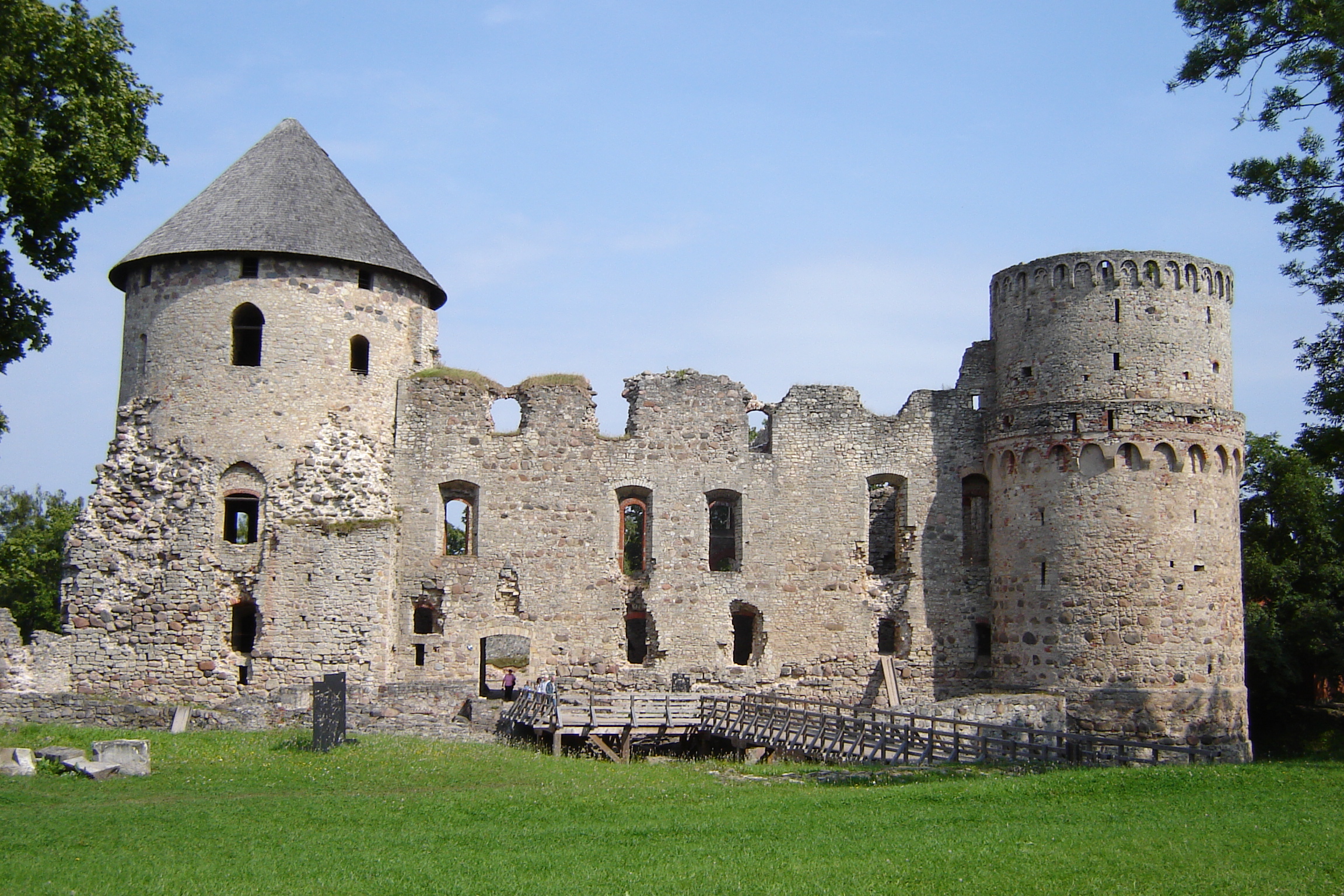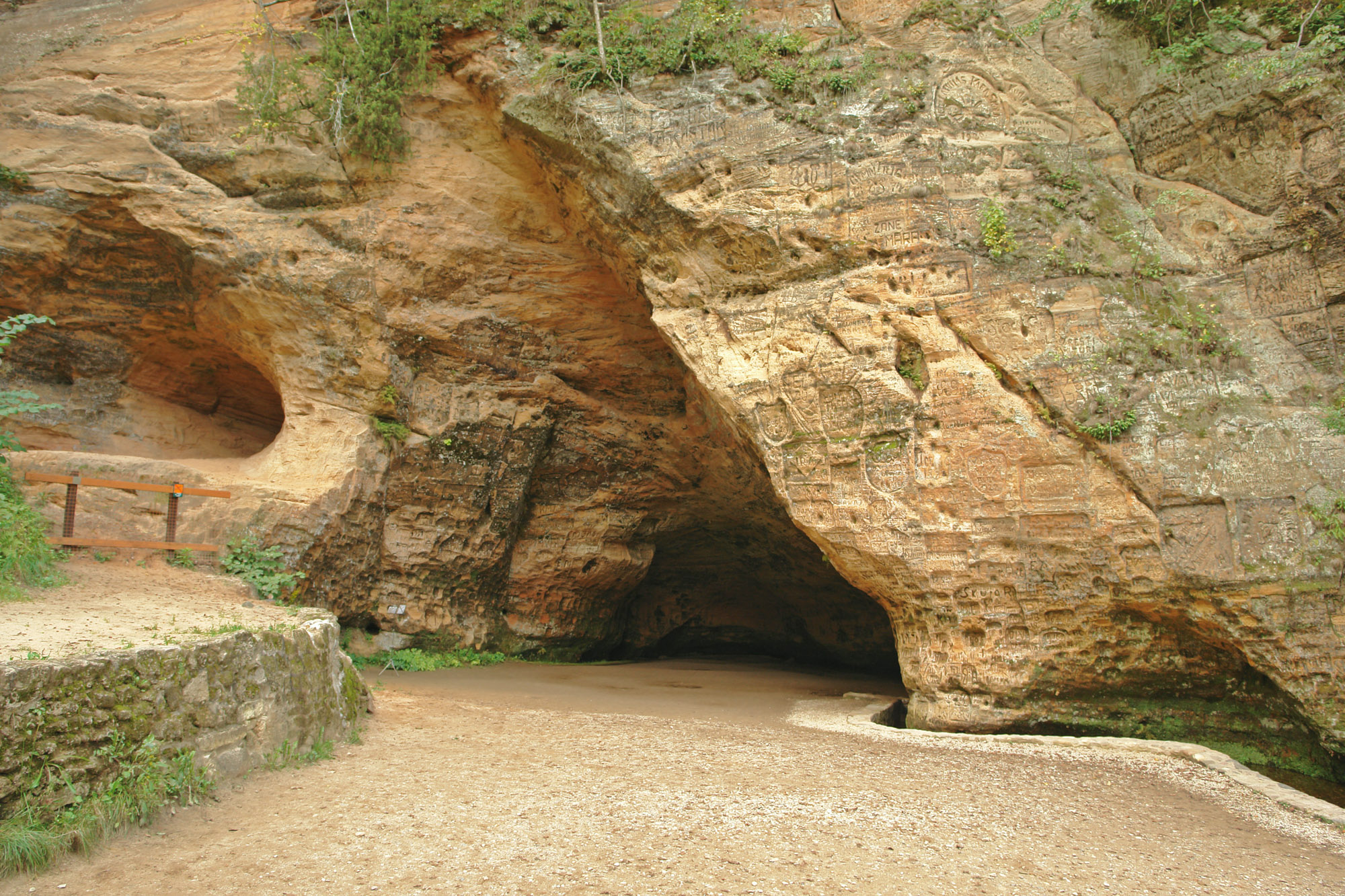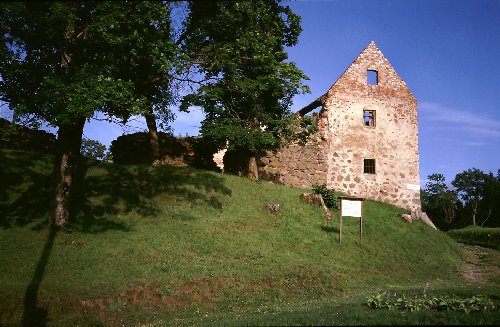|
Sigulda Castle
Sigulda Castle also known as Sigulda New Castle ( lv, Siguldas jaunā pils). Built in 1878 in the Neo-Gothic style as the living house for the owners of the manor, the Kropotkin family. The building has changed its owners and functions several times. Since 1993, the Sigulda Region Council has been located in the castle. History The manor center began to develop in the fore-castle area of Sigulda Medieval Castle during the 17th century. There are still a few remaining 18th and 19th century buildings built during the ownership of the Von Borghs and Kropotkins. These are the Summer Castle, the New Castle, the White Castle, the vagar's (supervisor of serfs) house, the servants' house, a barn, a laundry house and a vegetable and fruit basement. The manor center is enclosed by chipped boulder walls with a splendid gate structure. The New Castle was built during the time of Duchess Olga and Duke Dimitry Kropotkins from 1878 until 1881 using the materials from an older building which s ... [...More Info...] [...Related Items...] OR: [Wikipedia] [Google] [Baidu] |
Peter Kropotkin
Pyotr Alexeyevich Kropotkin (; russian: link=no, Пётр Алексе́евич Кропо́ткин ; 9 December 1842 – 8 February 1921) was a Russian anarchist, socialist, revolutionary, historian, scientist, philosopher, and activist who advocated anarcho-communism. Born into an aristocratic land-owning family, Kropotkin attended a military school and later served as an officer in Siberia, where he participated in several geological expeditions. He was imprisoned for his activism in 1874 and managed to escape two years later. He spent the next 41 years in exile in Switzerland, France (where he was imprisoned for almost four years) and England. While in exile, he gave lectures and published widely on anarchism and geography. Kropotkin returned to Russia after the Russian Revolution in 1917, but he was disappointed by the Bolshevik state. Kropotkin was a proponent of a decentralised communist society free from central government and based on voluntary association ... [...More Info...] [...Related Items...] OR: [Wikipedia] [Google] [Baidu] |
Sigulda Medieval Castle
Sigulda Medieval Castle ruins are located on the edge of the Gauja valley in Latvia. The original castle was built in 1207 as a castellum type fortress, later rebuilt into a convent type building. The residence of the Land Marshal of the Livonian Order since 1432. Due to its importance as a tourist attraction, the old castle walls have been fortified many times in the 20th century. The castle reopened its walls to visitors in 2012 and now encourages everyone to step back in time and enjoy the surroundings that bore witness to many historical events. It is possible to climb up the North Tower, the Main Gate Tower and enjoy the medieval aura. History Sigulda Medieval Castle was built by the Livonian Brothers of the Sword who were later incorporated into the Teutonic Order of the castle, thus the castle eventually became the property of the Livonian Order. The Livonian Brothers of the Sword, officially known as The Militia of Christ of Livonia, was a military order compos ... [...More Info...] [...Related Items...] OR: [Wikipedia] [Google] [Baidu] |
Baltic Region
The terms Baltic Sea Region, Baltic Rim countries (or simply the Baltic Rim), and the Baltic Sea countries/states refer to slightly different combinations of countries in the general area surrounding the Baltic Sea, mainly in Northern Europe. The term " Baltic states" refers specifically to one such grouping. Etymology The first to name it the ''Baltic Sea'' ( la, Mare Balticum) was 11th century German chronicler Adam of Bremen. Denotation Depending on the context the ''Baltic Sea Region'' might stand for: * The countries that have shorelines along the Baltic Sea: Denmark, Estonia, Finland, Germany, Latvia, Lithuania, Poland, Russia, and Sweden. * The group of countries that are members of the inter-governmental '' Baltic Assembly'' and '' Baltic Council of Ministers'', and generally referred to by the shorthand, Baltic states: Estonia, Latvia, and Lithuania. * Estonia, Latvia, Lithuania and Kaliningrad Oblast of Russia, exclaved from the remainder of Russia.«Th ... [...More Info...] [...Related Items...] OR: [Wikipedia] [Google] [Baidu] |
Atis Kronvalds
Atis Kronvalds or Kronvaldu Atis (15 April 1837 – 17 February 1875) was a Latvian writer, linguist and pedagogue, as well as a prominent member of the Young Latvia movement. Early life Kronvalds was born to a tailor family, but was raised by priests of Durbe. After studies in Liepāja he became a private teacher. In 1860 he started to study medicine at the University of Berlin; however, he left after half a year when he ran out of money. He returned to Latvia, where he resumed work as a private teacher in Durbe. Participation in "Young Latvians" movement After returning to Latvia, Kronvalds joined the Latvian nationalist movement "Young Latvians" and became a passionate advocate of Latvian rights, language, and culture. In 1865 he moved to Tartu to study pedagogy at the University of Tartu. In 1868 he became a teacher at the teacher seminary there. He participated in the social activities of local Latvian society; notably, he renewed the "Latvian evenings" tradition begun by ... [...More Info...] [...Related Items...] OR: [Wikipedia] [Google] [Baidu] |
World War II
World War II or the Second World War, often abbreviated as WWII or WW2, was a world war that lasted from 1939 to 1945. It involved the World War II by country, vast majority of the world's countries—including all of the great powers—forming two opposing military alliances: the Allies of World War II, Allies and the Axis powers. World War II was a total war that directly involved more than 100 million Military personnel, personnel from more than 30 countries. The major participants in the war threw their entire economic, industrial, and scientific capabilities behind the war effort, blurring the distinction between civilian and military resources. Air warfare of World War II, Aircraft played a major role in the conflict, enabling the strategic bombing of population centres and deploying the Atomic bombings of Hiroshima and Nagasaki, only two nuclear weapons ever used in war. World War II was by far the List of wars by death toll, deadliest conflict in hu ... [...More Info...] [...Related Items...] OR: [Wikipedia] [Google] [Baidu] |
Cēsis
Cēsis (), (german: Wenden, liv, Venden, et, Võnnu, pl, Kieś) is a town in Latvia located in the northern part of the Central Vidzeme Upland. Cēsis is on the Gauja River valley, and is built on a series of ridges above the river overlooking the woods below. Cēsis was one of the candidate cities for the title of European Capital of Culture 2014 (Riga was the Latvian city that won the title). Castle The oldest settlement in Cēsis is the hillfort on Riekstu hill, a fortified wooden castle built by a tribe known as the Vends. The mound with its partly preserved fortification system can still be seen in the Castle Park. This settlement was located near major trade routes from west to east and dominated the regional countryside. German crusaders known as the Livonian Brothers of the Sword began construction of a castle ''Wenden'' near the hill fort in 1209. When the castle was enlarged and fortified, it served as the residence for the Order's Master. In 1577, during t ... [...More Info...] [...Related Items...] OR: [Wikipedia] [Google] [Baidu] |
Sigulda
Sigulda (; german: Segewold, pl, Zygwold, russian: Сигулда) is a town in the Vidzeme region of Latvia, from the capital city Riga. Overview Sigulda is on a picturesque stretch of the Primeval forest, primeval Gauja river valley. Because of the reddish Devonian sandstone which forms steep rocks and caves on both banks of the river, Sigulda has been called the "Switzerland of Vidzeme". After the restoration of Latvian independence in 1991, an emphasis was placed on conserving Sigulda's public monuments and parks as well as improving the town's tourist sector. Supported by the town council, a traditional Opera Festival takes place in an open-air music hall in the castle ruins each summer. A Town Festival is celebrated in May when cherry trees blossom, while Sigulda is known for the colors of its trees in autumn. Sports such as skiing, bobsledding, and the luge are popular in wintertime and bungee jumping is practiced during the rest of the year. The Gutmanis Cave lies halfw ... [...More Info...] [...Related Items...] OR: [Wikipedia] [Google] [Baidu] |
Turaida Castle
Turaida Castle ( lv, Turaidas pils, german: Treiden, Treyden, russian: Турайдский замок; meaning ''Thor's garden'' in Livonian) is a recently reconstructed medieval castle in Turaida, in the Vidzeme region of Latvia, on the opposite bank of the Gauja River from Kurzeme. History Turaida castle dominates the Museum Reserve and is visually its most impressive element. When seen from the air, or the opposite bank of the river Gauja in Sigulda, Turaida castle can be seen rising above the treeline. From this view, the forepart of the castle is formed by the northern forecastle's gate tower. The main tower which is the highest is situated centrally, and the rear view forms the southern forecastle with its tower shaped southern section. Construction of the castle was started in 1214 upon directions given by Albert, Archbishop of Riga to his Livonian Brothers of the Sword (soon to merge with the Teutonic Order) at the place where the wooden castle of Livonians had previ ... [...More Info...] [...Related Items...] OR: [Wikipedia] [Google] [Baidu] |
Krimulda Castle
The Krimulda Castle (german: Burg Kremon) is located just outside Sigulda, Sigulda Municipality in the Vidzeme region of Latvia and is a tourist attraction. The castle dates from the 14th century and was destroyed in a war in 1601. Prince Liven’s living house was built in the classic style. The manor complex consists of steward’s house, coach house, Swiss cottage, etc. Home wine tasting is available by prior arrangement. History During the 13th century the left bank of the Gauja river was governed by the Order of the Brethren of the Sword, (later known as the Order of Livonia), while the territories on the right bank were under the domain of the Archbishop of Riga. Krimulda castle belonged to the Riga High Council which was a group of twelve high priests who advised the archbishop. Krimulda castle was built on the edge of a high bank on the right side of Gauja near the Vikmeste castle mound and the village of Livs. This placement made it nearly impossible to conquer. ... [...More Info...] [...Related Items...] OR: [Wikipedia] [Google] [Baidu] |
Castles In Latvia
This is the List of castles in Latvia, which includes fortified residences of Western European conquerors built in the area of present-day Latvia before the 17th century. There are about 140 medieval castles in the area, therefore this list is not complete. After the name of the castle comes the year of construction and a short description of its present-day condition. Table of contents Courland Zemgale Vidzeme Latgale See also * List of castles *List of castles in Estonia *List of palaces and manor houses in Estonia *List of palaces and manor houses in Latvia *List of hillforts in Latvia * List of castles in Lithuania Additional information References Sources * * External links Ambermarks - Medieval castles of Latvia - list {{List of castles in Europe * Latvia Cas Lists of castles by country Castles A castle is a type of fortified structure built during the Middle Ages predominantly by the nobility or royalty and by military orders. Scholars debate the ... [...More Info...] [...Related Items...] OR: [Wikipedia] [Google] [Baidu] |






